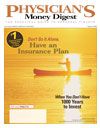Publication
Article
Physician's Money Digest
Don't Ignore the Basics of Saving
Author(s):
While many physician-investors have theirminds on stocks, bonds, and mutualfunds, they may overlook the simplebasics of saving. Fortunately, it's never too late toestablish a fundamental saving plan. You can begin byreviewing your monthly checking, bank, and creditcard statements. List all checks written, cash withdrawals,and credit card charges made. Includefinance charges. Move nonrecurring expenses to aseparate section. Add other expenses not paid thatmonth (eg, special occasion gifts, annual insurancepolicies, vacations, etc) to the special section. Takeyour monthly expenses, multiply by 12, and add yourexpected annual expenses. Divide the total by 12,then compare that number to your average monthlytake-home income. Which is greater? Now that youhave real information, you can begin to save.
Organize Your Saving Process
Start your saving process by determining whichdiscretionary expenditures are justified and reviewyour impulse spending. Buying a flat screen televisionat a 25% discount is not saving. Banking the 75%you would have spent is. Consider switching to cash-backcredit cards. But don't carry balances. Highinterest rates will offset anything you save.
Realize the Tax Implications
If you're in the 40% federal and state income taxbracket and you elect to defer $100 of your semimonthlypay, your paycheck decreases by only $60,while you put away $100. Invest that $100 tax-freeand pay tax on it only when you withdraw it fromyour retirement accounts. Self-employed physiciansor partners in a practice can set up qualified plans togenerate the same benefits. Although qualified plansmust also cover your employees, they can be designedto be beneficial to owners. Avoid strangling your cashflow by estimating your annual contribution inadvance, and make monthly or quarterly depositsinto your retirement account.
Automatic savings plans are another useful tool.Use direct deposit to send part of your net paydirectly to your savings account, not your checkingaccount. Another option is to set up an automaticfund transfer from checking to savings. Depositinto an account that's accessible for emergencywithdrawals. Withhold extra taxes from your paycheck.Yes, it's an interest-free loan to the government,but it is a form of savings, especially forthose with soft discipline. When you file yourreturn, have your refund deposited directly intoyour savings account. Ultimately, the opportunitycost of not earning interest for a year is better thannot saving that money at all.
Partners or self-employed physicians can avoidhefty interest and penalty charges by ensuring thatquarterly estimated tax payments fully cover their taxliability. For an extra savings boost, make a depositinto your savings account whenever you make yourestimated quarterly tax payments. Above all, don'tignore small opportunities for saving.
Justine DeVito Tenney, CPA, CFP®, MBA, is a partner in New YorkCity-based, Weiser LLP's Private Client Services practice, whoworks closely with medical practices, groups, and individuals. Fornearly a century, Weiser has provided accounting and consultingservices to professional services groups, business enterprises,and high-net-worth individuals. She welcomes questions or comments at 212-812-7000. For more information, visit www.weiserllp.com.
